MM320 Assignment 2: Analysis of Organizational Change Management
VerifiedAdded on 2022/09/01
|10
|2562
|22
Report
AI Summary
This report provides a comprehensive analysis of organizational change management within the Supreme Education Group. It begins with a restatement of the change discussed in a previous assignment. The report then critically examines the diagnostic methods employed, including the forms and levels of diagnosis used, such as the dialogic change approach and the Iceberg Model, and assesses the levels of analysis (individual, group, and organizational). It also analyzes the nature and levels of interventions implemented, considering both overt and covert strategies. The report further explores the communication strategies used during the change process, evaluating their effectiveness based on relevant theories. Finally, it reflects on how a change management consultant might approach the process differently, considering factors like the engagement of internal and external agents, the development of a strong leadership process, and the importance of a diverse workforce. The report emphasizes the need for systematic and scientific approaches to ensure successful change management, particularly in digital transformation.
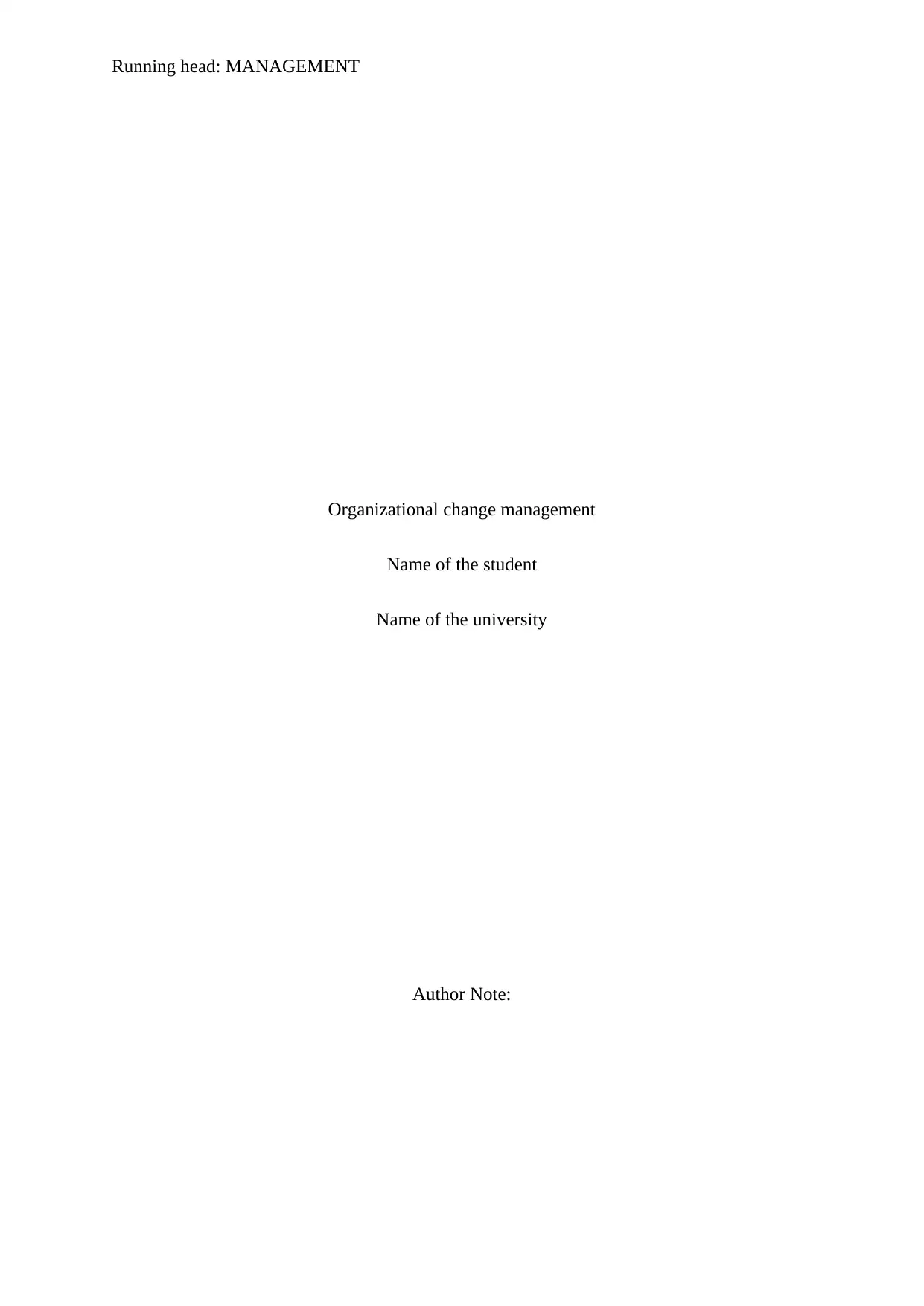
Running head: MANAGEMENT
Organizational change management
Name of the student
Name of the university
Author Note:
Organizational change management
Name of the student
Name of the university
Author Note:
Paraphrase This Document
Need a fresh take? Get an instant paraphrase of this document with our AI Paraphraser
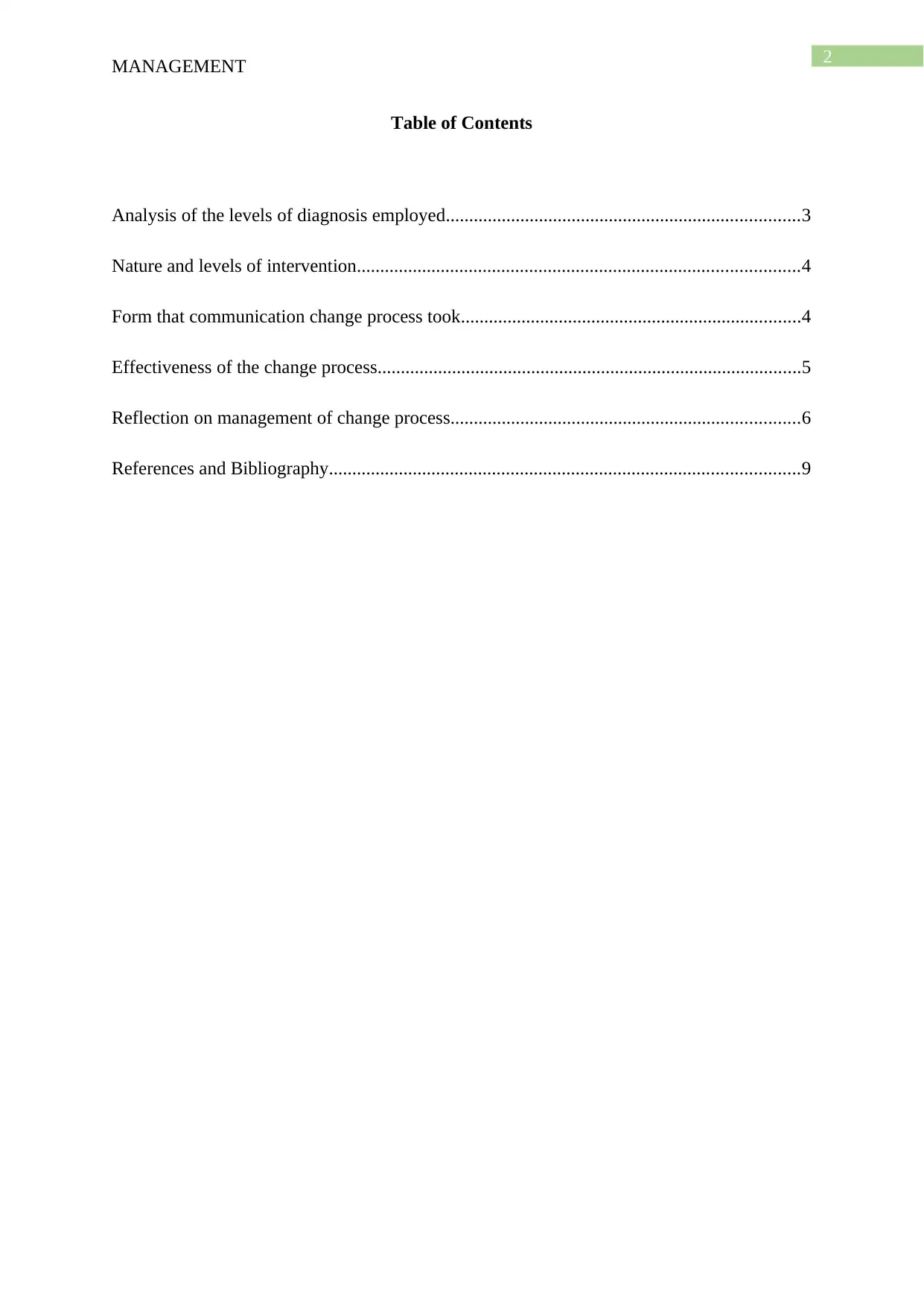
2
MANAGEMENT
Table of Contents
Analysis of the levels of diagnosis employed............................................................................3
Nature and levels of intervention...............................................................................................4
Form that communication change process took.........................................................................4
Effectiveness of the change process...........................................................................................5
Reflection on management of change process...........................................................................6
References and Bibliography.....................................................................................................9
MANAGEMENT
Table of Contents
Analysis of the levels of diagnosis employed............................................................................3
Nature and levels of intervention...............................................................................................4
Form that communication change process took.........................................................................4
Effectiveness of the change process...........................................................................................5
Reflection on management of change process...........................................................................6
References and Bibliography.....................................................................................................9
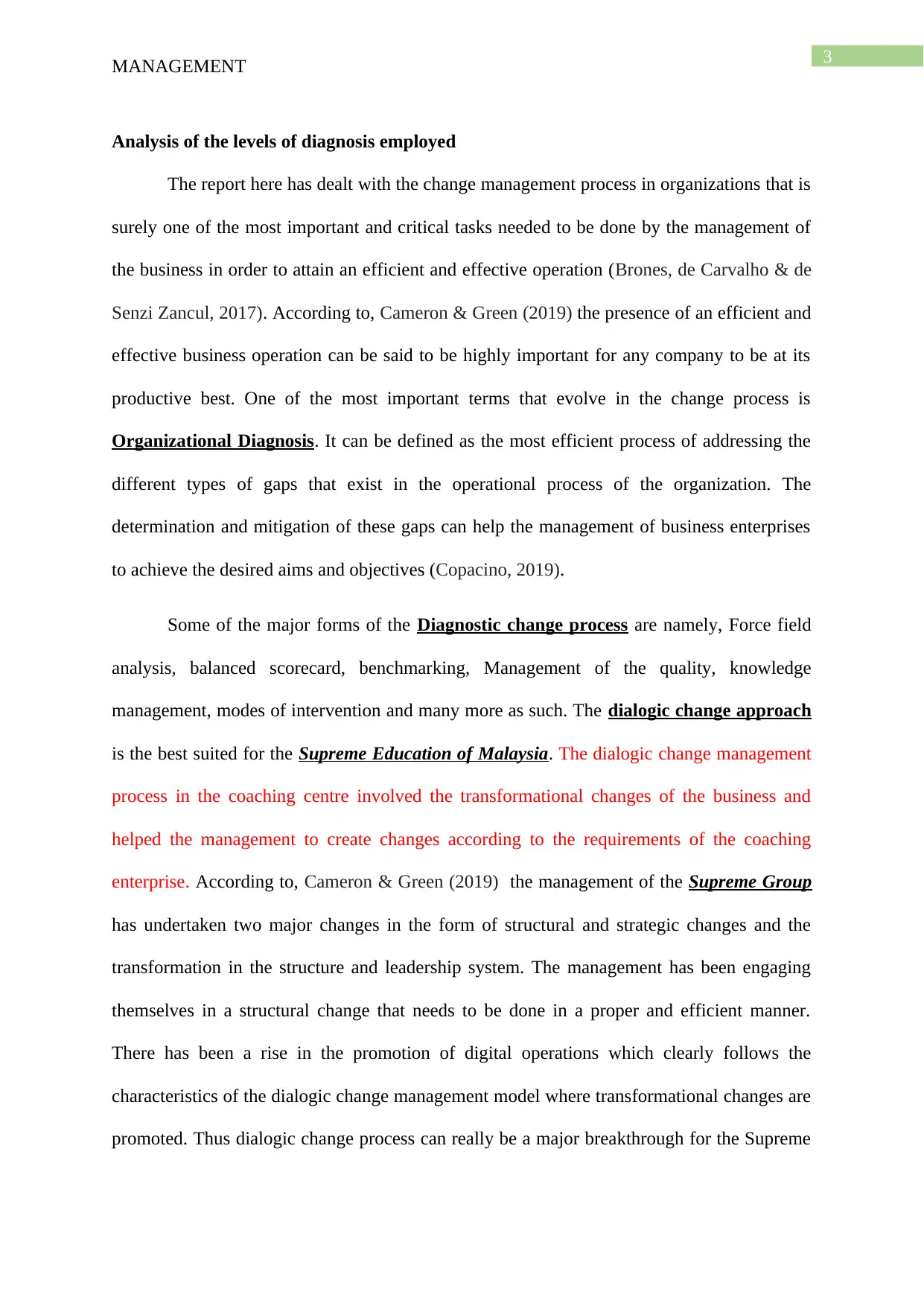
3
MANAGEMENT
Analysis of the levels of diagnosis employed
The report here has dealt with the change management process in organizations that is
surely one of the most important and critical tasks needed to be done by the management of
the business in order to attain an efficient and effective operation (Brones, de Carvalho & de
Senzi Zancul, 2017). According to, Cameron & Green (2019) the presence of an efficient and
effective business operation can be said to be highly important for any company to be at its
productive best. One of the most important terms that evolve in the change process is
Organizational Diagnosis. It can be defined as the most efficient process of addressing the
different types of gaps that exist in the operational process of the organization. The
determination and mitigation of these gaps can help the management of business enterprises
to achieve the desired aims and objectives (Copacino, 2019).
Some of the major forms of the Diagnostic change process are namely, Force field
analysis, balanced scorecard, benchmarking, Management of the quality, knowledge
management, modes of intervention and many more as such. The dialogic change approach
is the best suited for the Supreme Education of Malaysia. The dialogic change management
process in the coaching centre involved the transformational changes of the business and
helped the management to create changes according to the requirements of the coaching
enterprise. According to, Cameron & Green (2019) the management of the Supreme Group
has undertaken two major changes in the form of structural and strategic changes and the
transformation in the structure and leadership system. The management has been engaging
themselves in a structural change that needs to be done in a proper and efficient manner.
There has been a rise in the promotion of digital operations which clearly follows the
characteristics of the dialogic change management model where transformational changes are
promoted. Thus dialogic change process can really be a major breakthrough for the Supreme
MANAGEMENT
Analysis of the levels of diagnosis employed
The report here has dealt with the change management process in organizations that is
surely one of the most important and critical tasks needed to be done by the management of
the business in order to attain an efficient and effective operation (Brones, de Carvalho & de
Senzi Zancul, 2017). According to, Cameron & Green (2019) the presence of an efficient and
effective business operation can be said to be highly important for any company to be at its
productive best. One of the most important terms that evolve in the change process is
Organizational Diagnosis. It can be defined as the most efficient process of addressing the
different types of gaps that exist in the operational process of the organization. The
determination and mitigation of these gaps can help the management of business enterprises
to achieve the desired aims and objectives (Copacino, 2019).
Some of the major forms of the Diagnostic change process are namely, Force field
analysis, balanced scorecard, benchmarking, Management of the quality, knowledge
management, modes of intervention and many more as such. The dialogic change approach
is the best suited for the Supreme Education of Malaysia. The dialogic change management
process in the coaching centre involved the transformational changes of the business and
helped the management to create changes according to the requirements of the coaching
enterprise. According to, Cameron & Green (2019) the management of the Supreme Group
has undertaken two major changes in the form of structural and strategic changes and the
transformation in the structure and leadership system. The management has been engaging
themselves in a structural change that needs to be done in a proper and efficient manner.
There has been a rise in the promotion of digital operations which clearly follows the
characteristics of the dialogic change management model where transformational changes are
promoted. Thus dialogic change process can really be a major breakthrough for the Supreme
⊘ This is a preview!⊘
Do you want full access?
Subscribe today to unlock all pages.

Trusted by 1+ million students worldwide
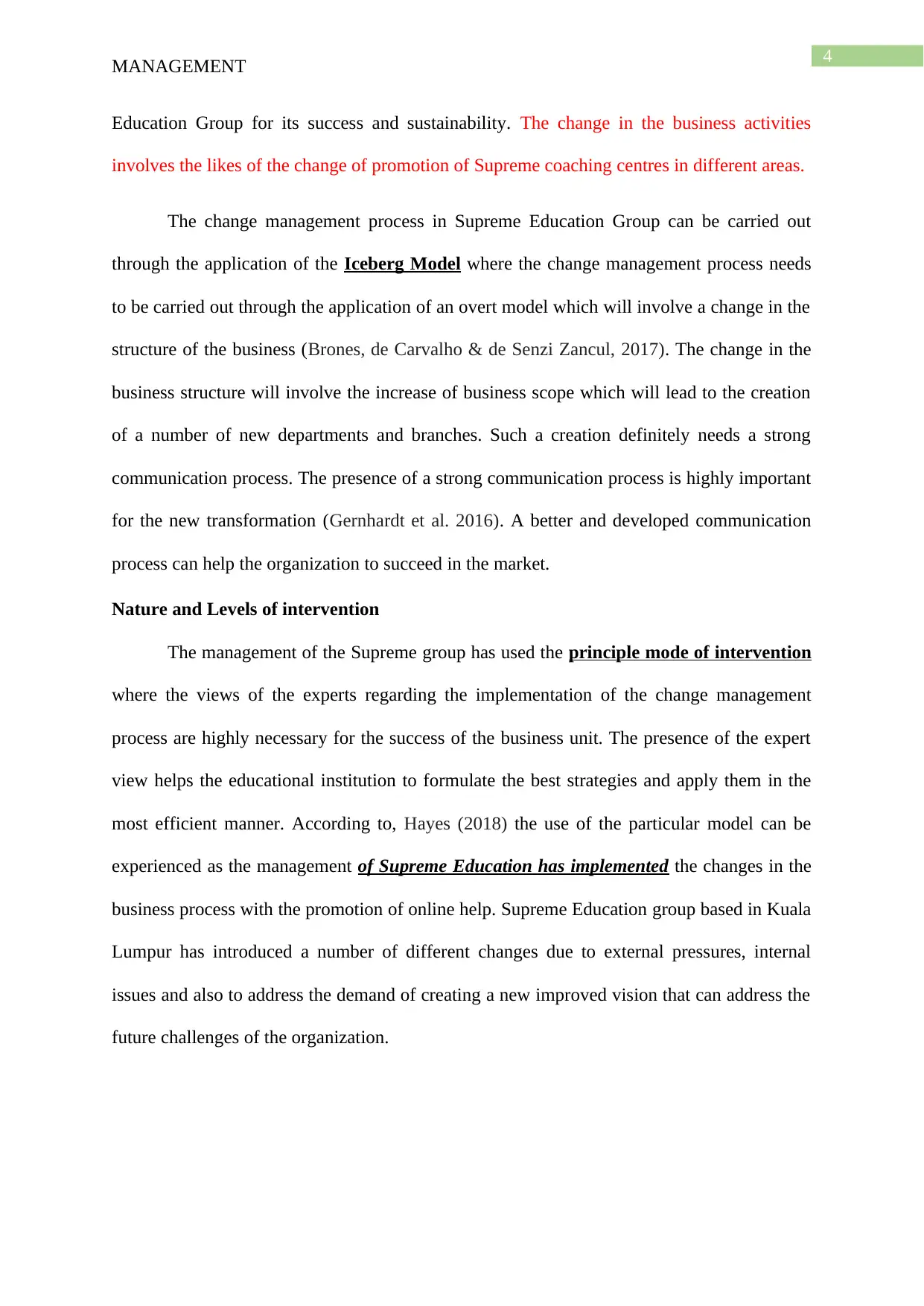
4
MANAGEMENT
Education Group for its success and sustainability. The change in the business activities
involves the likes of the change of promotion of Supreme coaching centres in different areas.
The change management process in Supreme Education Group can be carried out
through the application of the Iceberg Model where the change management process needs
to be carried out through the application of an overt model which will involve a change in the
structure of the business (Brones, de Carvalho & de Senzi Zancul, 2017). The change in the
business structure will involve the increase of business scope which will lead to the creation
of a number of new departments and branches. Such a creation definitely needs a strong
communication process. The presence of a strong communication process is highly important
for the new transformation (Gernhardt et al. 2016). A better and developed communication
process can help the organization to succeed in the market.
Nature and Levels of intervention
The management of the Supreme group has used the principle mode of intervention
where the views of the experts regarding the implementation of the change management
process are highly necessary for the success of the business unit. The presence of the expert
view helps the educational institution to formulate the best strategies and apply them in the
most efficient manner. According to, Hayes (2018) the use of the particular model can be
experienced as the management of Supreme Education has implemented the changes in the
business process with the promotion of online help. Supreme Education group based in Kuala
Lumpur has introduced a number of different changes due to external pressures, internal
issues and also to address the demand of creating a new improved vision that can address the
future challenges of the organization.
MANAGEMENT
Education Group for its success and sustainability. The change in the business activities
involves the likes of the change of promotion of Supreme coaching centres in different areas.
The change management process in Supreme Education Group can be carried out
through the application of the Iceberg Model where the change management process needs
to be carried out through the application of an overt model which will involve a change in the
structure of the business (Brones, de Carvalho & de Senzi Zancul, 2017). The change in the
business structure will involve the increase of business scope which will lead to the creation
of a number of new departments and branches. Such a creation definitely needs a strong
communication process. The presence of a strong communication process is highly important
for the new transformation (Gernhardt et al. 2016). A better and developed communication
process can help the organization to succeed in the market.
Nature and Levels of intervention
The management of the Supreme group has used the principle mode of intervention
where the views of the experts regarding the implementation of the change management
process are highly necessary for the success of the business unit. The presence of the expert
view helps the educational institution to formulate the best strategies and apply them in the
most efficient manner. According to, Hayes (2018) the use of the particular model can be
experienced as the management of Supreme Education has implemented the changes in the
business process with the promotion of online help. Supreme Education group based in Kuala
Lumpur has introduced a number of different changes due to external pressures, internal
issues and also to address the demand of creating a new improved vision that can address the
future challenges of the organization.
Paraphrase This Document
Need a fresh take? Get an instant paraphrase of this document with our AI Paraphraser
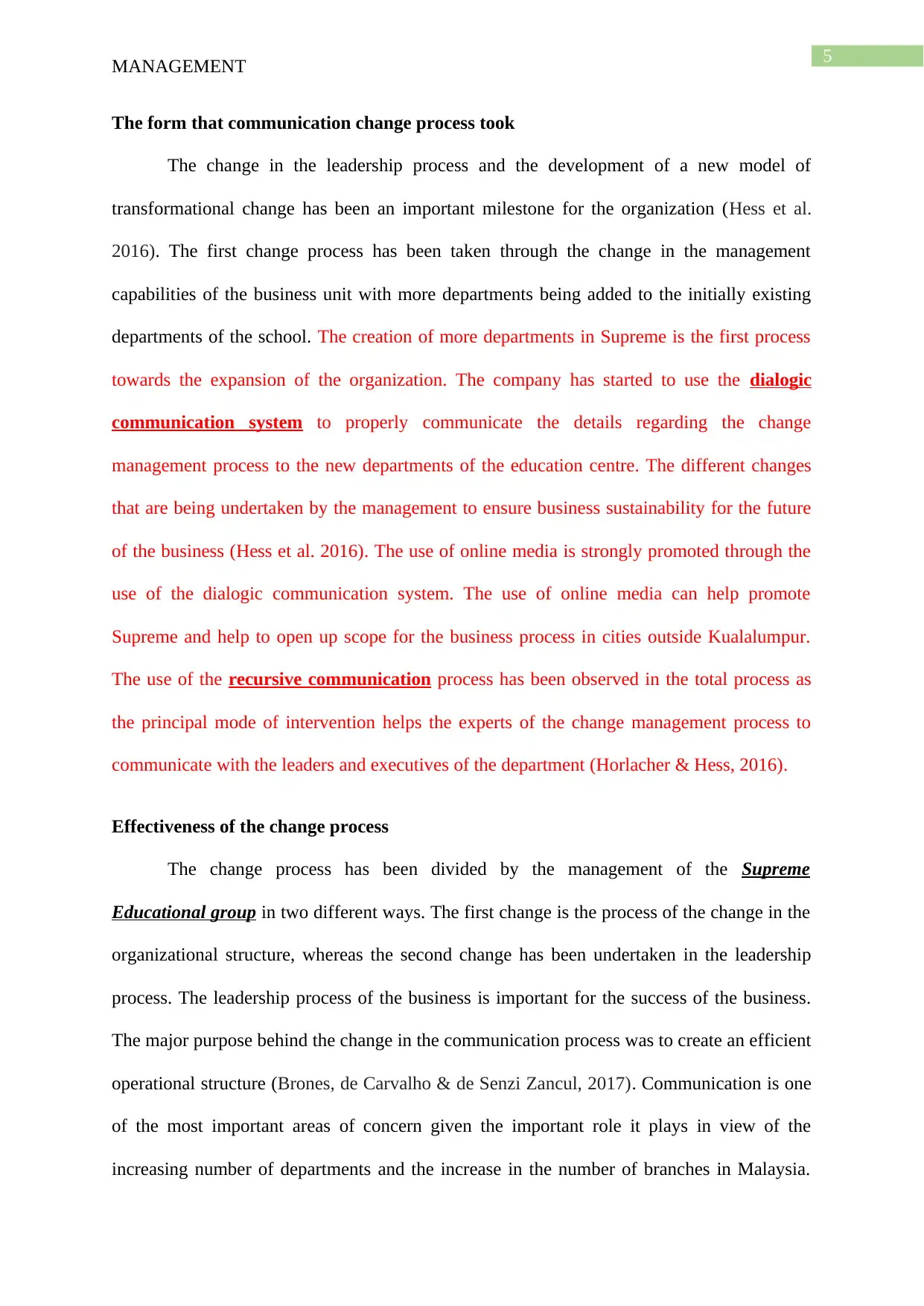
5
MANAGEMENT
The form that communication change process took
The change in the leadership process and the development of a new model of
transformational change has been an important milestone for the organization (Hess et al.
2016). The first change process has been taken through the change in the management
capabilities of the business unit with more departments being added to the initially existing
departments of the school. The creation of more departments in Supreme is the first process
towards the expansion of the organization. The company has started to use the dialogic
communication system to properly communicate the details regarding the change
management process to the new departments of the education centre. The different changes
that are being undertaken by the management to ensure business sustainability for the future
of the business (Hess et al. 2016). The use of online media is strongly promoted through the
use of the dialogic communication system. The use of online media can help promote
Supreme and help to open up scope for the business process in cities outside Kualalumpur.
The use of the recursive communication process has been observed in the total process as
the principal mode of intervention helps the experts of the change management process to
communicate with the leaders and executives of the department (Horlacher & Hess, 2016).
Effectiveness of the change process
The change process has been divided by the management of the Supreme
Educational group in two different ways. The first change is the process of the change in the
organizational structure, whereas the second change has been undertaken in the leadership
process. The leadership process of the business is important for the success of the business.
The major purpose behind the change in the communication process was to create an efficient
operational structure (Brones, de Carvalho & de Senzi Zancul, 2017). Communication is one
of the most important areas of concern given the important role it plays in view of the
increasing number of departments and the increase in the number of branches in Malaysia.
MANAGEMENT
The form that communication change process took
The change in the leadership process and the development of a new model of
transformational change has been an important milestone for the organization (Hess et al.
2016). The first change process has been taken through the change in the management
capabilities of the business unit with more departments being added to the initially existing
departments of the school. The creation of more departments in Supreme is the first process
towards the expansion of the organization. The company has started to use the dialogic
communication system to properly communicate the details regarding the change
management process to the new departments of the education centre. The different changes
that are being undertaken by the management to ensure business sustainability for the future
of the business (Hess et al. 2016). The use of online media is strongly promoted through the
use of the dialogic communication system. The use of online media can help promote
Supreme and help to open up scope for the business process in cities outside Kualalumpur.
The use of the recursive communication process has been observed in the total process as
the principal mode of intervention helps the experts of the change management process to
communicate with the leaders and executives of the department (Horlacher & Hess, 2016).
Effectiveness of the change process
The change process has been divided by the management of the Supreme
Educational group in two different ways. The first change is the process of the change in the
organizational structure, whereas the second change has been undertaken in the leadership
process. The leadership process of the business is important for the success of the business.
The major purpose behind the change in the communication process was to create an efficient
operational structure (Brones, de Carvalho & de Senzi Zancul, 2017). Communication is one
of the most important areas of concern given the important role it plays in view of the
increasing number of departments and the increase in the number of branches in Malaysia.
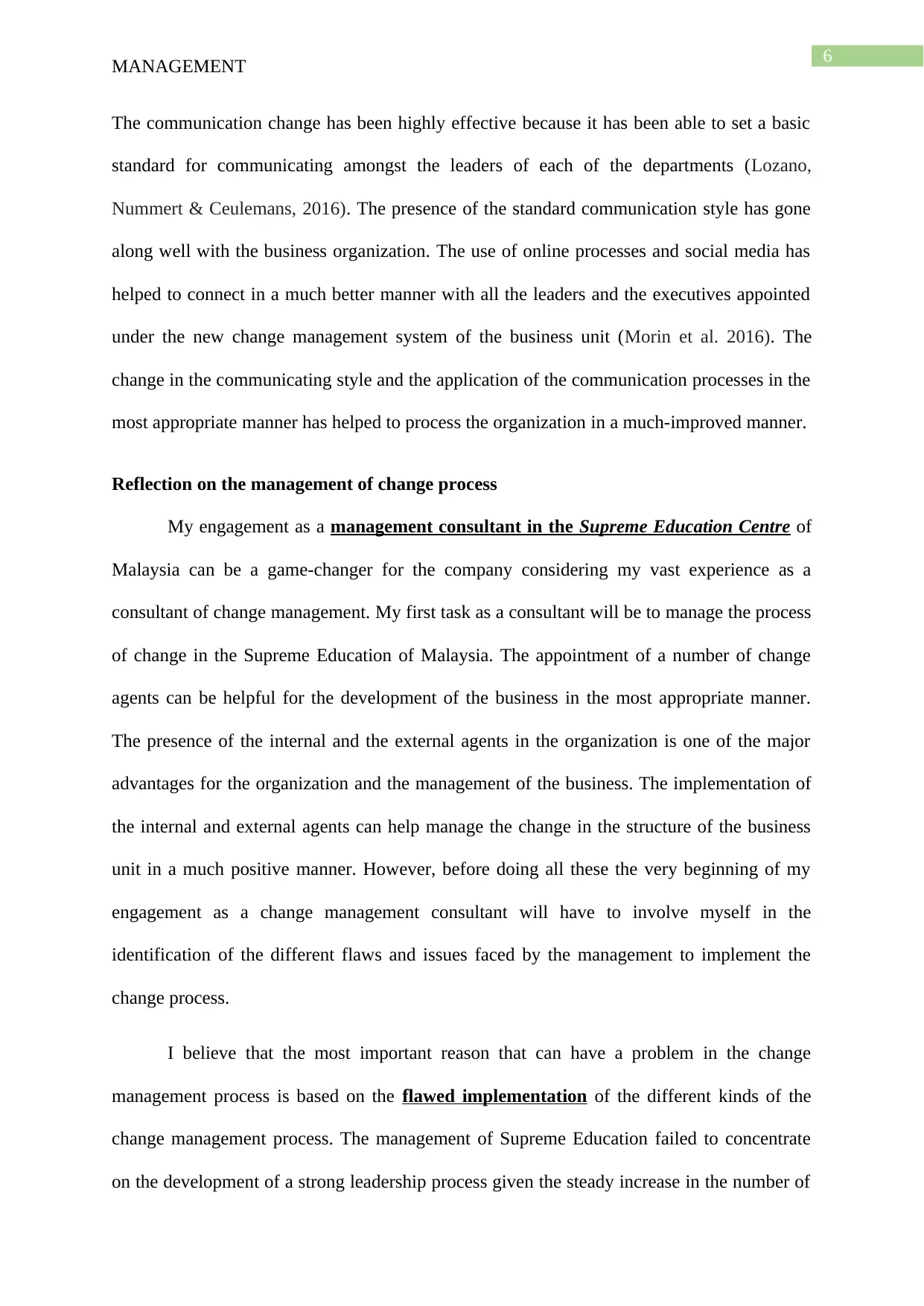
6
MANAGEMENT
The communication change has been highly effective because it has been able to set a basic
standard for communicating amongst the leaders of each of the departments (Lozano,
Nummert & Ceulemans, 2016). The presence of the standard communication style has gone
along well with the business organization. The use of online processes and social media has
helped to connect in a much better manner with all the leaders and the executives appointed
under the new change management system of the business unit (Morin et al. 2016). The
change in the communicating style and the application of the communication processes in the
most appropriate manner has helped to process the organization in a much-improved manner.
Reflection on the management of change process
My engagement as a management consultant in the Supreme Education Centre of
Malaysia can be a game-changer for the company considering my vast experience as a
consultant of change management. My first task as a consultant will be to manage the process
of change in the Supreme Education of Malaysia. The appointment of a number of change
agents can be helpful for the development of the business in the most appropriate manner.
The presence of the internal and the external agents in the organization is one of the major
advantages for the organization and the management of the business. The implementation of
the internal and external agents can help manage the change in the structure of the business
unit in a much positive manner. However, before doing all these the very beginning of my
engagement as a change management consultant will have to involve myself in the
identification of the different flaws and issues faced by the management to implement the
change process.
I believe that the most important reason that can have a problem in the change
management process is based on the flawed implementation of the different kinds of the
change management process. The management of Supreme Education failed to concentrate
on the development of a strong leadership process given the steady increase in the number of
MANAGEMENT
The communication change has been highly effective because it has been able to set a basic
standard for communicating amongst the leaders of each of the departments (Lozano,
Nummert & Ceulemans, 2016). The presence of the standard communication style has gone
along well with the business organization. The use of online processes and social media has
helped to connect in a much better manner with all the leaders and the executives appointed
under the new change management system of the business unit (Morin et al. 2016). The
change in the communicating style and the application of the communication processes in the
most appropriate manner has helped to process the organization in a much-improved manner.
Reflection on the management of change process
My engagement as a management consultant in the Supreme Education Centre of
Malaysia can be a game-changer for the company considering my vast experience as a
consultant of change management. My first task as a consultant will be to manage the process
of change in the Supreme Education of Malaysia. The appointment of a number of change
agents can be helpful for the development of the business in the most appropriate manner.
The presence of the internal and the external agents in the organization is one of the major
advantages for the organization and the management of the business. The implementation of
the internal and external agents can help manage the change in the structure of the business
unit in a much positive manner. However, before doing all these the very beginning of my
engagement as a change management consultant will have to involve myself in the
identification of the different flaws and issues faced by the management to implement the
change process.
I believe that the most important reason that can have a problem in the change
management process is based on the flawed implementation of the different kinds of the
change management process. The management of Supreme Education failed to concentrate
on the development of a strong leadership process given the steady increase in the number of
⊘ This is a preview!⊘
Do you want full access?
Subscribe today to unlock all pages.

Trusted by 1+ million students worldwide
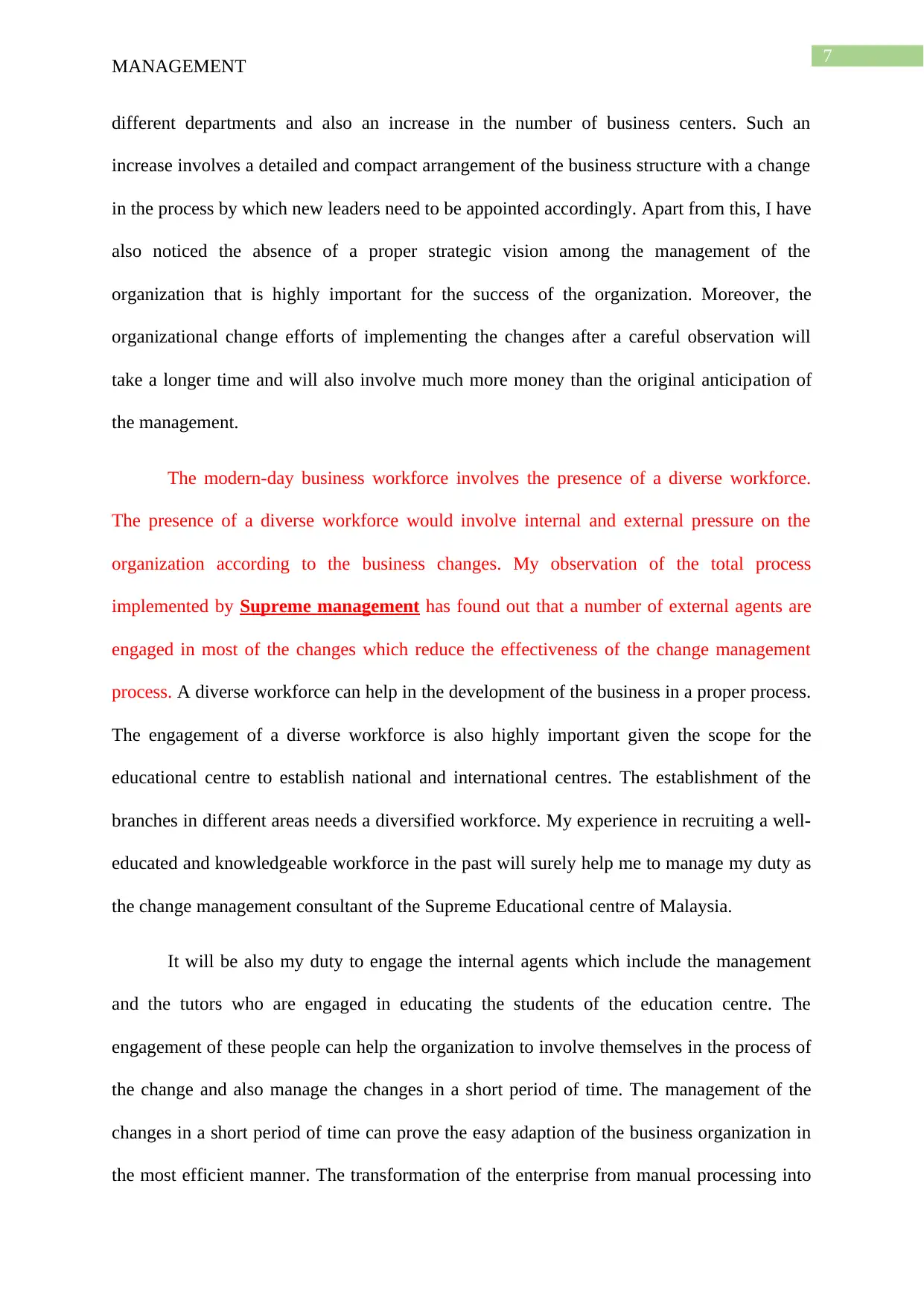
7
MANAGEMENT
different departments and also an increase in the number of business centers. Such an
increase involves a detailed and compact arrangement of the business structure with a change
in the process by which new leaders need to be appointed accordingly. Apart from this, I have
also noticed the absence of a proper strategic vision among the management of the
organization that is highly important for the success of the organization. Moreover, the
organizational change efforts of implementing the changes after a careful observation will
take a longer time and will also involve much more money than the original anticipation of
the management.
The modern-day business workforce involves the presence of a diverse workforce.
The presence of a diverse workforce would involve internal and external pressure on the
organization according to the business changes. My observation of the total process
implemented by Supreme management has found out that a number of external agents are
engaged in most of the changes which reduce the effectiveness of the change management
process. A diverse workforce can help in the development of the business in a proper process.
The engagement of a diverse workforce is also highly important given the scope for the
educational centre to establish national and international centres. The establishment of the
branches in different areas needs a diversified workforce. My experience in recruiting a well-
educated and knowledgeable workforce in the past will surely help me to manage my duty as
the change management consultant of the Supreme Educational centre of Malaysia.
It will be also my duty to engage the internal agents which include the management
and the tutors who are engaged in educating the students of the education centre. The
engagement of these people can help the organization to involve themselves in the process of
the change and also manage the changes in a short period of time. The management of the
changes in a short period of time can prove the easy adaption of the business organization in
the most efficient manner. The transformation of the enterprise from manual processing into
MANAGEMENT
different departments and also an increase in the number of business centers. Such an
increase involves a detailed and compact arrangement of the business structure with a change
in the process by which new leaders need to be appointed accordingly. Apart from this, I have
also noticed the absence of a proper strategic vision among the management of the
organization that is highly important for the success of the organization. Moreover, the
organizational change efforts of implementing the changes after a careful observation will
take a longer time and will also involve much more money than the original anticipation of
the management.
The modern-day business workforce involves the presence of a diverse workforce.
The presence of a diverse workforce would involve internal and external pressure on the
organization according to the business changes. My observation of the total process
implemented by Supreme management has found out that a number of external agents are
engaged in most of the changes which reduce the effectiveness of the change management
process. A diverse workforce can help in the development of the business in a proper process.
The engagement of a diverse workforce is also highly important given the scope for the
educational centre to establish national and international centres. The establishment of the
branches in different areas needs a diversified workforce. My experience in recruiting a well-
educated and knowledgeable workforce in the past will surely help me to manage my duty as
the change management consultant of the Supreme Educational centre of Malaysia.
It will be also my duty to engage the internal agents which include the management
and the tutors who are engaged in educating the students of the education centre. The
engagement of these people can help the organization to involve themselves in the process of
the change and also manage the changes in a short period of time. The management of the
changes in a short period of time can prove the easy adaption of the business organization in
the most efficient manner. The transformation of the enterprise from manual processing into
Paraphrase This Document
Need a fresh take? Get an instant paraphrase of this document with our AI Paraphraser
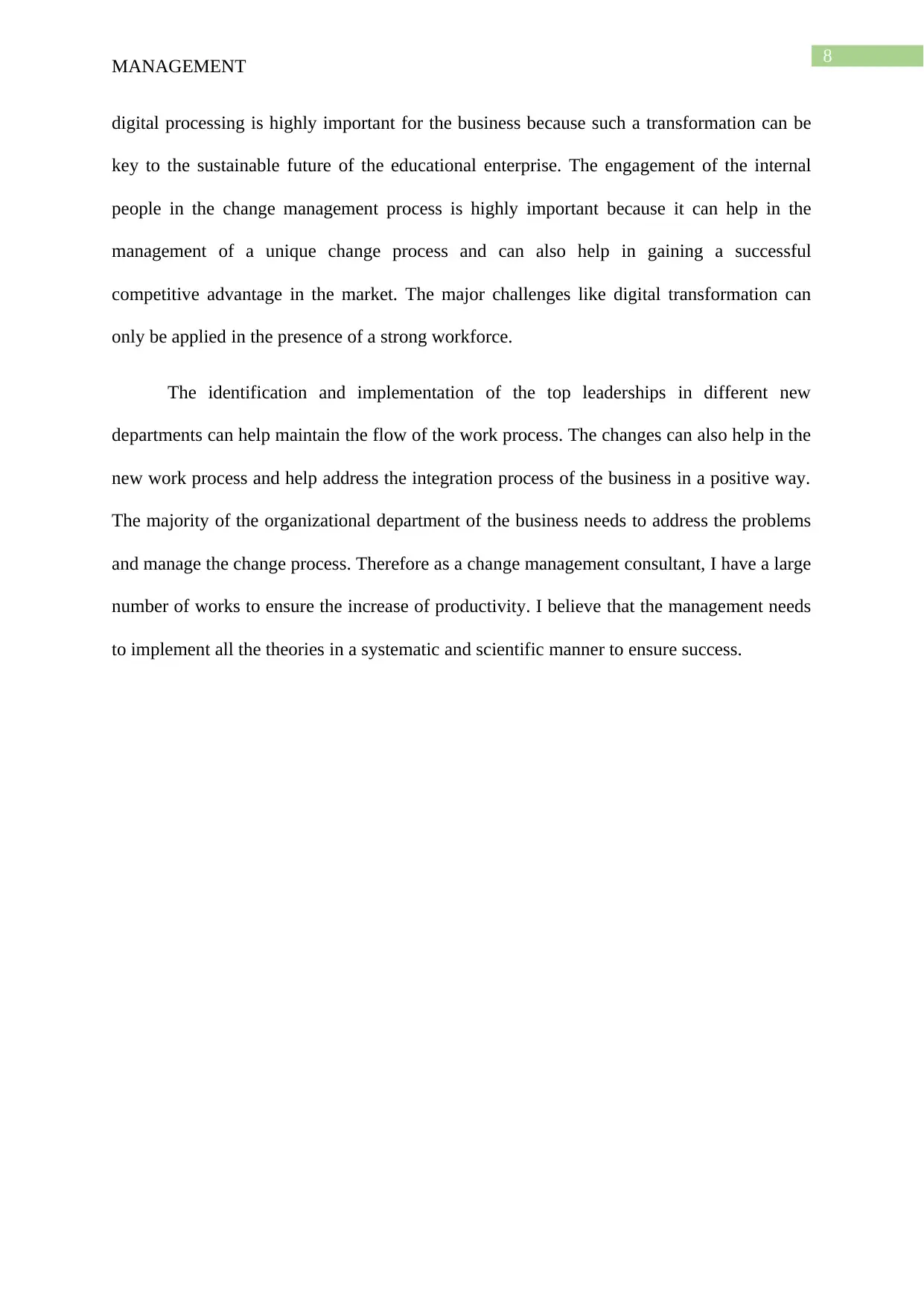
8
MANAGEMENT
digital processing is highly important for the business because such a transformation can be
key to the sustainable future of the educational enterprise. The engagement of the internal
people in the change management process is highly important because it can help in the
management of a unique change process and can also help in gaining a successful
competitive advantage in the market. The major challenges like digital transformation can
only be applied in the presence of a strong workforce.
The identification and implementation of the top leaderships in different new
departments can help maintain the flow of the work process. The changes can also help in the
new work process and help address the integration process of the business in a positive way.
The majority of the organizational department of the business needs to address the problems
and manage the change process. Therefore as a change management consultant, I have a large
number of works to ensure the increase of productivity. I believe that the management needs
to implement all the theories in a systematic and scientific manner to ensure success.
MANAGEMENT
digital processing is highly important for the business because such a transformation can be
key to the sustainable future of the educational enterprise. The engagement of the internal
people in the change management process is highly important because it can help in the
management of a unique change process and can also help in gaining a successful
competitive advantage in the market. The major challenges like digital transformation can
only be applied in the presence of a strong workforce.
The identification and implementation of the top leaderships in different new
departments can help maintain the flow of the work process. The changes can also help in the
new work process and help address the integration process of the business in a positive way.
The majority of the organizational department of the business needs to address the problems
and manage the change process. Therefore as a change management consultant, I have a large
number of works to ensure the increase of productivity. I believe that the management needs
to implement all the theories in a systematic and scientific manner to ensure success.
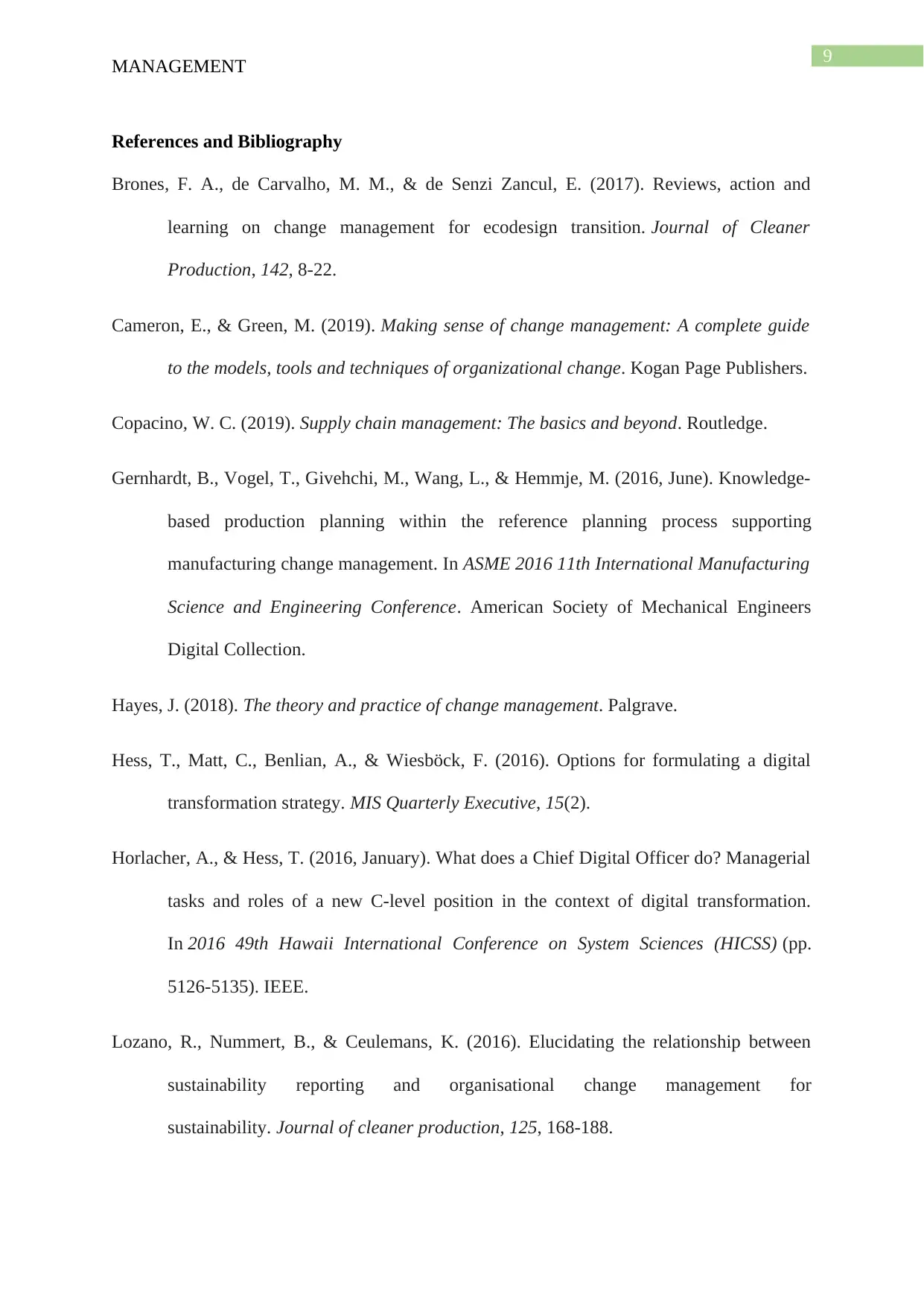
9
MANAGEMENT
References and Bibliography
Brones, F. A., de Carvalho, M. M., & de Senzi Zancul, E. (2017). Reviews, action and
learning on change management for ecodesign transition. Journal of Cleaner
Production, 142, 8-22.
Cameron, E., & Green, M. (2019). Making sense of change management: A complete guide
to the models, tools and techniques of organizational change. Kogan Page Publishers.
Copacino, W. C. (2019). Supply chain management: The basics and beyond. Routledge.
Gernhardt, B., Vogel, T., Givehchi, M., Wang, L., & Hemmje, M. (2016, June). Knowledge-
based production planning within the reference planning process supporting
manufacturing change management. In ASME 2016 11th International Manufacturing
Science and Engineering Conference. American Society of Mechanical Engineers
Digital Collection.
Hayes, J. (2018). The theory and practice of change management. Palgrave.
Hess, T., Matt, C., Benlian, A., & Wiesböck, F. (2016). Options for formulating a digital
transformation strategy. MIS Quarterly Executive, 15(2).
Horlacher, A., & Hess, T. (2016, January). What does a Chief Digital Officer do? Managerial
tasks and roles of a new C-level position in the context of digital transformation.
In 2016 49th Hawaii International Conference on System Sciences (HICSS) (pp.
5126-5135). IEEE.
Lozano, R., Nummert, B., & Ceulemans, K. (2016). Elucidating the relationship between
sustainability reporting and organisational change management for
sustainability. Journal of cleaner production, 125, 168-188.
MANAGEMENT
References and Bibliography
Brones, F. A., de Carvalho, M. M., & de Senzi Zancul, E. (2017). Reviews, action and
learning on change management for ecodesign transition. Journal of Cleaner
Production, 142, 8-22.
Cameron, E., & Green, M. (2019). Making sense of change management: A complete guide
to the models, tools and techniques of organizational change. Kogan Page Publishers.
Copacino, W. C. (2019). Supply chain management: The basics and beyond. Routledge.
Gernhardt, B., Vogel, T., Givehchi, M., Wang, L., & Hemmje, M. (2016, June). Knowledge-
based production planning within the reference planning process supporting
manufacturing change management. In ASME 2016 11th International Manufacturing
Science and Engineering Conference. American Society of Mechanical Engineers
Digital Collection.
Hayes, J. (2018). The theory and practice of change management. Palgrave.
Hess, T., Matt, C., Benlian, A., & Wiesböck, F. (2016). Options for formulating a digital
transformation strategy. MIS Quarterly Executive, 15(2).
Horlacher, A., & Hess, T. (2016, January). What does a Chief Digital Officer do? Managerial
tasks and roles of a new C-level position in the context of digital transformation.
In 2016 49th Hawaii International Conference on System Sciences (HICSS) (pp.
5126-5135). IEEE.
Lozano, R., Nummert, B., & Ceulemans, K. (2016). Elucidating the relationship between
sustainability reporting and organisational change management for
sustainability. Journal of cleaner production, 125, 168-188.
⊘ This is a preview!⊘
Do you want full access?
Subscribe today to unlock all pages.

Trusted by 1+ million students worldwide
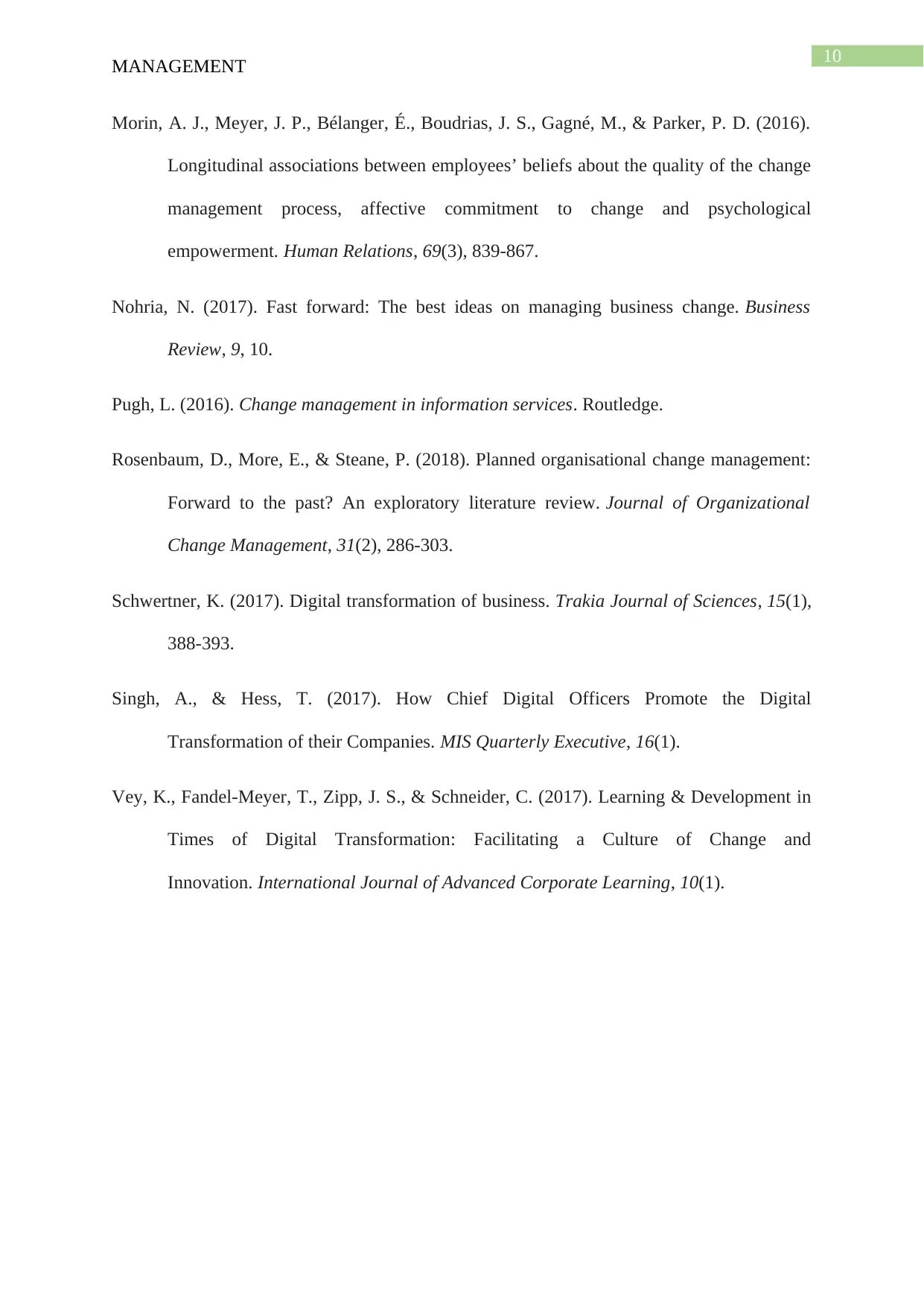
10
MANAGEMENT
Morin, A. J., Meyer, J. P., Bélanger, É., Boudrias, J. S., Gagné, M., & Parker, P. D. (2016).
Longitudinal associations between employees’ beliefs about the quality of the change
management process, affective commitment to change and psychological
empowerment. Human Relations, 69(3), 839-867.
Nohria, N. (2017). Fast forward: The best ideas on managing business change. Business
Review, 9, 10.
Pugh, L. (2016). Change management in information services. Routledge.
Rosenbaum, D., More, E., & Steane, P. (2018). Planned organisational change management:
Forward to the past? An exploratory literature review. Journal of Organizational
Change Management, 31(2), 286-303.
Schwertner, K. (2017). Digital transformation of business. Trakia Journal of Sciences, 15(1),
388-393.
Singh, A., & Hess, T. (2017). How Chief Digital Officers Promote the Digital
Transformation of their Companies. MIS Quarterly Executive, 16(1).
Vey, K., Fandel-Meyer, T., Zipp, J. S., & Schneider, C. (2017). Learning & Development in
Times of Digital Transformation: Facilitating a Culture of Change and
Innovation. International Journal of Advanced Corporate Learning, 10(1).
MANAGEMENT
Morin, A. J., Meyer, J. P., Bélanger, É., Boudrias, J. S., Gagné, M., & Parker, P. D. (2016).
Longitudinal associations between employees’ beliefs about the quality of the change
management process, affective commitment to change and psychological
empowerment. Human Relations, 69(3), 839-867.
Nohria, N. (2017). Fast forward: The best ideas on managing business change. Business
Review, 9, 10.
Pugh, L. (2016). Change management in information services. Routledge.
Rosenbaum, D., More, E., & Steane, P. (2018). Planned organisational change management:
Forward to the past? An exploratory literature review. Journal of Organizational
Change Management, 31(2), 286-303.
Schwertner, K. (2017). Digital transformation of business. Trakia Journal of Sciences, 15(1),
388-393.
Singh, A., & Hess, T. (2017). How Chief Digital Officers Promote the Digital
Transformation of their Companies. MIS Quarterly Executive, 16(1).
Vey, K., Fandel-Meyer, T., Zipp, J. S., & Schneider, C. (2017). Learning & Development in
Times of Digital Transformation: Facilitating a Culture of Change and
Innovation. International Journal of Advanced Corporate Learning, 10(1).
1 out of 10
Your All-in-One AI-Powered Toolkit for Academic Success.
+13062052269
info@desklib.com
Available 24*7 on WhatsApp / Email
![[object Object]](/_next/static/media/star-bottom.7253800d.svg)
Unlock your academic potential
Copyright © 2020–2025 A2Z Services. All Rights Reserved. Developed and managed by ZUCOL.
